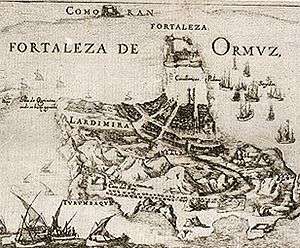Persian–Portuguese war

The Persian–Portuguese war took place between 1507 and 1622 and involved the Portuguese Empire and its vassal, the Kingdom of Ormus, on one side, and the Safavid Empire with the help of the Kingdom of England on the other side. During this era, Portugal established its rule for about eighty years in Ormuz and Bahrain, capturing some other islands and ports such as Qeshm and Bandar Abbas for few years. The conflict came to an end when the Safavid king, Abbas I, conquered the Portuguese territories forcing them to leave the Persian Gulf.
In September 1507, the Portuguese Afonso de Albuquerque landed on the Hormoz. Portugal occupied Ormuz from 1515 to 1622. As a vassal of the Portuguese state, the Kingdom of Ormus jointly participated in the 1521 invasion of Bahrain that ended Jabrid rule of the Persian Gulf archipelago.
After the Portuguese made several abortive attempts to seize control of Basra, the Safavid ruler Abbas I conquered Ormus with the help of the English, and expelled the Portuguese from the rest of the Persian Gulf, with the exception of Muscat. The Portuguese returned to the Persian Gulf in the following year as allies of Afrasiyab, the Pasha of Basra, against the Persians.
Capture of Ormuz by Portuguese

The capture of Ormuz was a result of a plan by the king of Portugal, Manuel I, who in 1505 had resolved to thwart Muslim trade in the Indian Ocean by capturing Aden, to block trade through Alexandria; Ormuz, to block trade through Beirut; and Malacca to control trade with China.[1] A fleet under Tristão da Cunha was sent to capture the Muslim fort on Socotra in order to control the entrance to the Red Sea; this was accomplished in 1507. The main part of the fleet then left for India, with a few ships remaining under Albuquerque.[2]
Albuquerque disobeyed orders and left to capture the island of Ormuz.[2] He obtained the submission of the local king to the king of Portugal, as well as the authorisation to build a fort using local labour.[3] He started to build a fort on 27 October 1507, and initially planned to man it with a garrison, but could not hold it because of local resistance and the defection to India of several of his Portuguese captains.[2][3][4]
Capture of Bahrain
As a vassal of the Portuguese state, the Kingdom of Ormus jointly participated in the 1521 invasion of Bahrain that ended Jabrid rule of the Bahrain archipelago. The Jabrid ruler was nominally a vassal of Ormus, but the Jabrid King, Muqrin ibn Zamil, had refused to pay the tribute Ormus demanded, prompting the invasion under the command of the Portuguese conqueror, António Correia.[5] In the fighting for Bahrain, most of the combat was carried out by Portuguese troops, while the Ormusi admiral, Reis Xarafo, looked on.[6] The Portuguese ruled Bahrain through a series of Ormusi governors. However, the Sunni Ormusi were not popular with Bahrain's Shia population which suffered religious disadvantages,[7] prompting rebellion. In one case, the Ormusi governor was crucified by rebels,[8] and Portuguese rule came to an end in 1602 after the Ormusi governor, who was a relative of the Ormusi king,[9] started executing members of Bahrain's leading families.[10]
Persian reconquest
By the order of Abbas I, in 1602, the Persian army under the command of Imam-Quli Khan, managed to expel the Portuguese from Bahrain.[11]
In 1612, the Portuguese Empire took the city of Gamrūn and transliterated the name to Comorão. Almost two years later (in 1615), Comorão was taken by ‘Abbās the Great after a naval battle with the Portuguese and renamed Bandar-e ‘Abbās, or "Port of ‘Abbās". In 1622, with the help of four English ships, Abbas retook Hormuz from the Portuguese in the Capture of Ormuz (1622).[12]
In 1622 when the Persians retook Hormuz, the Portuguese Empire was the one of the largest and one of the most powerful empires in the world. The defeat of the Portuguese had many consequences including defeat in the Mombasa war and the capture of Fort Jesus by the Imam of Muscat, supported by the Persian king.
With the Arab/Baluchi seizure of Portugal's key foothold at Fort Jesus on Mombasa Island (now in Kenya) in 1698, the Portuguese Empire declined and lost most of its land in east Africa to the British. The British recognised the Persian empire as only sovereign of the entire Persian Gulf and it was mentioned in the article 5 of the Preliminary Treaty of Friendship and Alliance in 1809. This recognition would be modified in subsequent negotiations including the Definitive Treaty of Friendship and Alliance, 1812, and the Treaty of Tehran, 1814, and remained the framework of Anglo–Persian relations over the next half century. [13]
References
- ↑ Malabar manual by William Logan p.312
- 1 2 3 The New Cambridge Modern History: The Reformation, 1520-1559 Geoffrey Rudolph Elton p.662
- 1 2 Albuquerque Henry Morse Stephens p.54ff
- ↑ Foundations of the Portuguese empire, 1415-1580 Bailey Wallys Diffie p.472
- ↑ Sanjay Subrahmanyam, The Career and Legend of Vasco da Gama, Cambridge University Press, 1997, 288
- ↑ James Silk Buckingham Travels in Assyria, Media, and Persia, Oxford University Press, 1829, p459
- ↑ Juan Cole, Sacred Space and Holy War, IB Tauris, 2007 pp39
- ↑ Charles Belgrave, Personal Column, Hutchinson, 1960 p98
- ↑ Charles Belgrave, The Pirate Coast, G. Bell & Sons, 1966 p6
- ↑ Curtis E. Larsen. Life and Land Use on the Bahrain Islands: The Geoarchaeology of an Ancient Society University Of Chicago Press, 1984 p69
- ↑ Juan R. I. Cole, "Rival Empires of Trade and Imami Shiism in Eastern Arabia, 1300-1800", p. 186, through JSTOR.
- ↑ Nahavandi and Bomati pp.159-162
- ↑ سمینار بین المللی ایران و آفریقا ۱۳۸۱دانشگاه تربیت مدرس- یونسکو- جلد دوم مقاله ایرانیان بلوچ در جنگ ممباسا دکتر عجم چاپ 1383 دانشگاه تربیت مدرس. Documents on the Persian Gulf's name : the eternal heritage of ancient time pp. 84-85-204-205